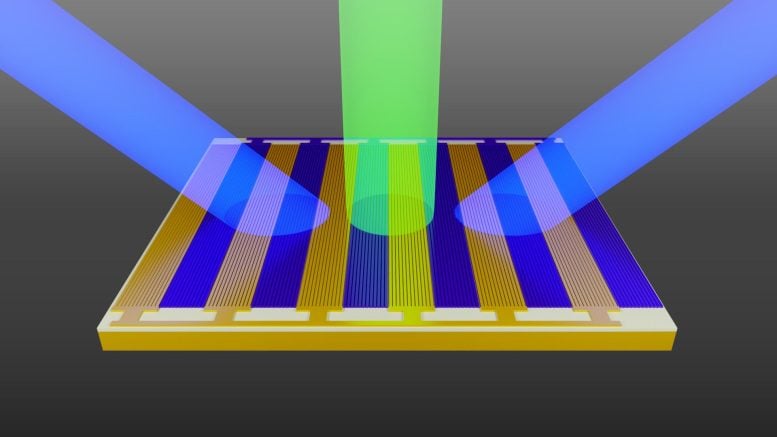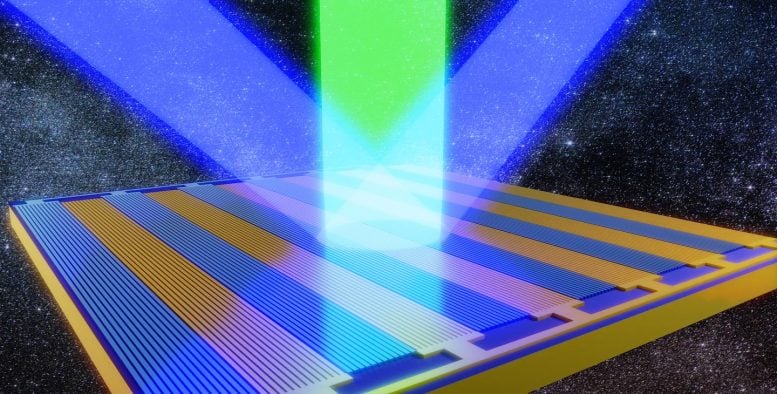
A new metasurface developed by Caltech can split a light beam into several channels, enhancing wireless communication and data transmission capabilities at optical frequencies, with potential applications in space communication and LiDAR. Credit: Caltech
Caltech engineers have introduced an innovative metasurface that manipulates light to provide multiple communication channels at optical frequencies.
This technology promises to enhance data transmission in various fields including space communications and LiDAR, moving beyond traditional electronic methods and offering substantial bandwidth improvements.
Revolutionizing Wireless Communication With Metasurfaces
It is a scene many of us are familiar with: You’re working on your laptop at the local coffee shop with maybe a half dozen other laptop users—each of you is trying to load websites or stream high-definition videos, and all are craving more bandwidth. Now imagine that each of you had a dedicated wireless channel for communication that was hundreds of times faster than the Wi-Fi we use today, with hundreds of times more bandwidth. That dream may not be far off thanks to the development of metasurfaces—tiny engineered sheets that can reflect and otherwise direct light in desired ways.
Breakthrough in Optical Metasurface Technology
In a paper published on July 24 in the journal Nature Nanotechnology, a team of Caltech engineers reports building such a metasurface patterned with miniscule tunable antennas capable of reflecting an incoming beam of optical light to create many sidebands, or channels, of different optical frequencies.
“With these metasurfaces, we’ve been able to show that one beam of light comes in, and multiple beams of light go out, each with different optical frequencies and going in different directions,” says Harry Atwater, the Otis Booth Leadership Chair of the Division of Engineering and Applied Science, the Howard Hughes Professor of Applied Physics and Materials Science, and senior author on the new paper. “It’s acting like an entire array of communication channels. And we’ve found a way to do this for free-space signals rather than signals carried on an optical fiber.”
The work points to a promising route for the development of not only a new type of wireless communication channel but also potentially new range-finding technologies and even a novel way to relay larger amounts of data to and from space.

An incident laser beam (green) hits Caltech’s new space-time metasurface and gets modulated by tunable, nanostructured antennas, creating steerable beams of light at different frequencies (blue) that could be used as optical channels for transmitting data on Earth or in space. Credit: Caltech
The Mechanics of Metasurfaces: Beyond Traditional Optics
Co-lead author on the new paper Prachi Thureja, a graduate student in Atwater’s group, says to understand their work, first consider the word “metasurface.” The root, “meta,” comes from a Greek prefix meaning “beyond.” Metasurfaces are designed to go beyond what we can do with conventional bulky optical elements, such as camera or microscope lenses. The multilayer transistor-like devices are engineered with a carefully selected pattern of Future Applications and Universal Connectivity
Beyond demonstrating that such a metasurface is capable of splitting and redirecting light at optical frequencies in free space (rather than in optical fibers), the team says the work points to several possible applications. These metasurfaces could be useful in LiDAR applications, the light equivalent of radar, where light is used to capture the depth information from a three-dimensional scene. The ultimate dream is to develop a “universal metasurface” that would create multiple optical channels, each carrying information in different directions in free space. “If optical metasurfaces become a realizable technology that proliferates, a decade from now you’ll be able to sit in a Starbucks with a bunch of other people on their laptops and instead of each person getting a radio frequency Wi-Fi signal, they will get their own high-fidelity light beam signal,” says Atwater, who is also the director of the Liquid Sunlight Alliance at Caltech. “One metasurface will be able to beam a different frequency to each person.” The group is collaborating with the Optical Communications Laboratory at SciTechDaily